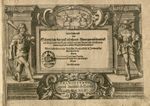|
|
You are not currently logged in. Are you accessing the unsecure (http) portal? Click here to switch to the secure portal. |
Scola, overo teatro (Nicoletto Giganti)
| Scola, overo teatro | |
|---|---|
| School, or Theater | |
 | |
| Full title | Scola, overo teatro, nelquale sono rappresentate diverse maniere, e modi di parare, e di ferire di spada sola, e di spada, e pugnala |
| Author(s) | Nicoletto Giganti |
| Illustrated by | Odoarco Fialetti |
| Dedicated to | Cosimo II de' Medici |
| Place of origin | Venezia |
| Language | Italian |
| Genre(s) | Fencing manual |
| Publisher | Giovanni Antonio & Giacomo de' Franceschi |
| Publication date | 1606, 1610, 1619, 1622, 1628, 1644 |
| Pages | 95 pages |
| Treatise scans |
|
Scola, overo teatro ("School, or Theater") is an Italian fencing manual written by Nicoletto Giganti and printed in 1606. It treats the use of the single rapier and the rapier and dagger. The treatise is structured as a series of progressively more complex lessons, and Tom Leoni opines that this treatise is the best pedagogical work on rapier fencing of its time.[1] Based on the number of republications over the succeeding decades it seems to have been quite popular, and fencing historians have praised it both for its organization and as the first text to fully describe the use of the lunge.
Contents
Publication History
Scola, overo teatro was first printed in Venice in 1606 by Giovanni Antonio and Giacomo de' Franceschi, with illustrations by Odoarco Fialetti. The Grand Duchy of Tuscany granted Giganti a special protection against unauthorized reprints for a term of 30 years, including a fine of 300 ducats. This copyright was repeatedly ignored, however, including a 1628 edition published in Padua by Paolo Frambotto, which included an additional dedication from the publisher to Lazaro Stubick di Kœnigstein. Bibliographies also list printings in 1608 and 1610; the first is probably a mistaken reference to Libro secondo, whereas the second seems to be spurious (or possibly a mistaken reference to the treatise of Ridolfo Capo Ferro).
In 1619, still within the copyright period, the treatise was translated into French and German and published in Frankfurt by Jacob de Zeter. He published it under separate French and German titles, Escrime Novvelle ov Theatre ("New Fencing or Theater") and Newe Fechtkunst Oder Schawplatz ("New Fencing Art or Show Place") respectively, containing the main text in both languages but the preface in only one. This edition is often bound with Zetter's 1622 translation of book II of Salvator Fabris' treatise,[2], but it's unclear if this represents a new printing of the Giganti edition or a separate work that was added to it in order to increase sales.[3] This edition has oddly lead various fencing historians to accuse Giganti himself of plagiarism.[4] In 1644, unsold copies were sold as a new edition, including a new title page but merely covering the year 1622 on the title of the second section with a paper saying "1644".
In 2010, Scola, overo teatro was translated into English by Tom Leoni and published by Freelance Academy Press under the title Venetian Rapier: The School, or Salle. A second English translation, titled Nicoletto Giganti's the School of the Sword was released in 2014 by Aaron Taylor Mediema.
Contents
| i - v | Preface by Nicoletto Giganti |
|---|---|
| vii - xiv | Publisher's preface |
| 1 - 47 | Rapier by Nicoletto Giganti |
| 48 - 95 | Rapier and dagger by Nicoletto Giganti |
Gallery
Title pages
Illustrations
Additional Resources
The following is a list of publications containing scans, transcriptions, and translations relevant to this article, as well as published peer-reviewed research.
- Giganti, Nicoletto (2010). Venetian Rapier: The School, or Salle. Nicoletto Giganti's 1606 Rapier Fencing Curriculum. Trans. by Tom Leoni. Wheaton: Freelance Academy Press. ISBN 978-0-9825911-2-3.
- Giganti, Nicoletto (2014). Nicoletto Giganti's the School of the Sword: A New Translation by Aaron Taylor Miedema. Trans. by Aaron Taylor Miedema. Legacy Books Press. ISBN 978-1927537077.
References
- ↑ Leoni, p xi.
- ↑ The Fabris edition might also have been published in 1619, but no extant copies of the 1619 seem to include it.
- ↑ All extant copies are dated 1619 in the Giganti portion and 1622 in the Fabris portion.
- ↑ This accusation was first made by Johann Joachim Hynitzsch, who attributed the edition to Giganti rather than Zeter and was incensed that he gave no credit to Fabris.
Copyright and License Summary
For further information, including transcription and translation notes, see the discussion page.
| Work | Author(s) | Source | License |
|---|---|---|---|
| Images | Odoarco Fialetti | Corble Collection | |
| Transcription | Jeff Vansteenkiste | Index:Scola, overo teatro (Nicoletto Giganti) |

















































